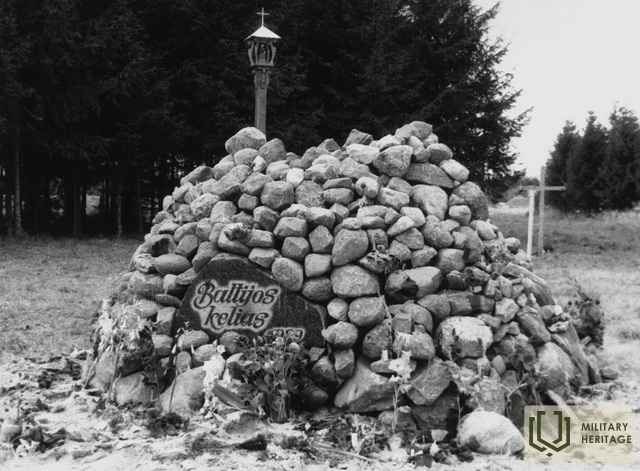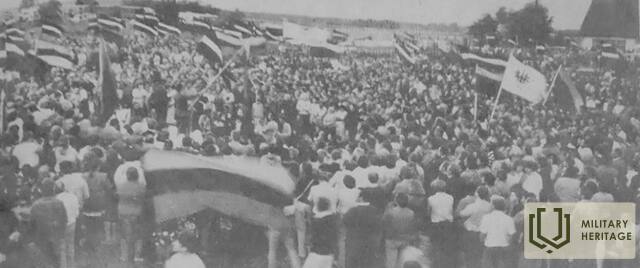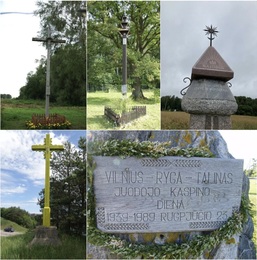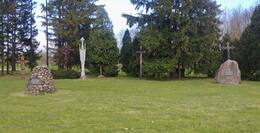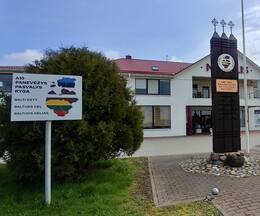Source: Living Testimonies of the Baltic Way
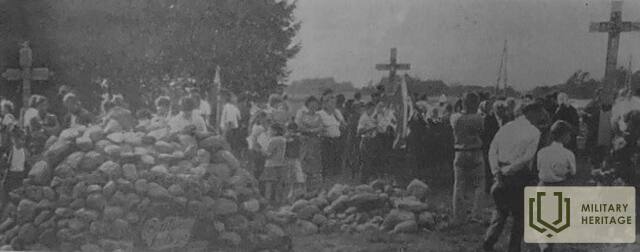
Through the eyes of journalists, the film tells the story of the impressions and emotions of the participants of the Baltic Way in 1989, and the shared experiences of Lithuanians and Latvians that day.
Excerpts from the article "Baltic Road, August 23, 1989. Pasvalys: from despair - or already into hope?" published in the Pasvalys regional newspaper "Darbas" on August 26, 1989, which impressively and sensitively conveys the emotions of the Baltic Road and the unity of Lithuanians and Latvians.
At that hour, when a sea of flags from Latvia and another from Lithuania floated on the Lithuanian-Latvian border, when people stood next to people, when a bonfire sparked from Lithuanian and Latvian torches, and 50 beats of the tambourine from Lithuania were answered by 50 beats of the Latvian bell – we remembered that moment a year ago – only a year ago! – when Arvydas Juozaitis shouted his passionate slogan to the crowd in Biržai:
– Lithuania is a force!
How much gray disbelief there was in the crowd then – and how much trust in us today! I still feel the warm, fraternal palms in my hands. At that appointed 7 p.m. [June 23, 1989, Baltic Way Day], there were so many of us, so many that we not only joined hands, but also supported each other in many places. Who would have believed that when Sąjūdis called, all of Lithuania would hear again. They would hear – and they would not remain indifferent!
An hour before the human wall action. An endless stream of cars, the roadside full of groups, groups celebrating the new crosses of the Baltic Way. There were so many of us that even the members of the Sąjūdis Seimas who were going to the Pasvalys Park rally got stuck on the road and the words they were supposed to deliver to the people were not delivered at the intended place. Let's not be angry. That day, the most important thing was not words, but our will to be united, all together. We were there. Probably because of this, the understanding of how important the unity of the people of the three nations [Lithuanians, Latvians and Estonians] is strengthened. We all raised rallies, everywhere in a Lithuanian calm calm, befitting this day. […] You had to see the entire 47-kilometer section through our [Pasvalys] district to feel that Lithuanian strength – not threatening anyone, but ready to defend your rights and honor seriously and with dignity. And we probably all felt the spirit and strength of our campaign thanks to the live radio broadcast, which was heard throughout the Baltics.
It was not easy to get to the rally at the Lithuanian-Latvian border: in the first hours after the human border […] the road could no longer accommodate cars. And there were many thousands of Lithuanians and Latvians at the rally. They sang and talked until dark. After the Latvian choir and the mournful song of our singer F. Adomonienė sounded, the anthems rang out powerfully. Agris Freimanis, a member of the Duma of the Latvian People's Front, and Romualdas Ozolas, a member of the Seimas Council of the Lithuanian Peristarkymo Sąjūdis, addressed the people. They assessed the consequences of the crime that occurred 50 years ago, and expressed the aspirations of our peoples. […]
The leaders of the rally, Kaunas Drama Theater actor, our compatriot Petras Venslovs, and his colleague, an actress from Latvia, were invited to repeat their words for a long time:
– Lithuania, be free! Latvia, be free! Estonia, be free!
That evening, flags were lowered as the sacred fire was lit – sacrifice, suffering, the desire for freedom. Then they rose high with powerful words of freedom.
And once again we saw the Baltic Way – a running ribbon of car lights…
* * *
Days and years will pass. When entering Lithuania, a Latvian will be greeted by a Lithuanian guardian right at the border (a sculpture created for this wall by Algirdas Butkevičius from Biržai), crosses of August 23 will stand on the road, covered with flowers and wreaths. At the northern border of Pasvalys, around the stone altar of our captivity, the ensemble of Baltic crosses was born [all the mentioned objects and places have survived even after more than 30 years!]. How the new monuments shone with candles on the road!
R. Butėnienė, A. Kazlauskas, "The Baltic Way, 1989. August 23. Pasvalys: from despair - or already to hope?", in: Darbas, 1989-08-26 (no. 102–103), p. 1.
Related objects
Monuments along the Baltic Way section to commemorate the Baltic Way
Along the Baltic Road from Vilnius to Škilinpamūšis.
On August 23, 1989, to commemorate the 50th anniversary of the signing of the criminal Molotov-Ribbentrop Pact and its secret protocols, a human chain was formed by the Lithuanian Reorganization Movement, the Latvian People's Front, and the Estonian People's Front, connecting the capitals of the three Baltic states – Vilnius, Riga, and Tallinn. 2 million people joined hands in a chain about 650 km long. This chain, known as the Baltic Way, is one of the most striking and memorable events in the Soviet-occupied countries' quest for independence.
The Baltic Way was for some time listed in the Guinness Book of World Records as the longest human chain, and the documentary heritage testifying to this event was included in the UNESCO International Register “Memory of the World”. However, alongside these global and international forms of commemoration, there are also more modest, but no less eloquent, forms. In Lithuania, signs dedicated to its memory have been erected along the entire Baltic Way (the road ran along the Vilnius–Ukmergė–Panevėžys–Pasvalys section). In the Pasvalys district alone, there are 12 such signs of memory today – monuments made of various materials and in various forms. And there are several dozen of them along the entire section. The monuments were erected on the initiative of the Baltic Way participants themselves.
The Baltic Way in Lithuania began in Vilnius from the Gediminas Castle Tower. Today, this starting point is marked by a medallion embedded in the castle stone. And in the Šeškinė microdistrict of Vilnius (along the Ukmergė highway, at Ukmergės g. 24) there is a wooden monument in the form of a chapel pillar, which can be considered the symbolic beginning of the marked path. Its symbolic end is the sign of the connection of the Lithuanian and Latvian sections of the Baltic Way, located 200 km away near Saločiai.
Cross Valley to Commemorate the Baltic Way
The Cross Valley to Commemorate the Baltic Way memorial is located on the eastern outskirts of Pasvalys on the Via Baltica motorway (E67, A10).
On 23 August 1989, to commemorate the occasion of the 50th anniversary of the signing of the criminal Molotov-Ribbentrop Pact and its secret protocol, based on the initiative of the Lithuanian reform movement “Sąjūdis”, the Latvian People’s Front and the Estonian People’s Front, a live human chain linked the capitals of the three Baltic states – Vilnius, Riga and Tallinn. Holding hands, approximately two million people joined together in a living chain that was about 650 km long. This chain, known as the Baltic Way, is one of the most remarkable and memorable events on the road to independence of the countries occupied
by the Soviets.
To commemorate this event, memorial signs have been erected along the Baltic Way route (Vilnius-Ukmergė-Panevėžys- Pasvalys-Saločiai). The Cross Valley to Commemorate the Baltic Way is one of the monuments dedicated to this memorial route. The history of Cross Valley began on the eve of the Baltic Way when the residents of Pasvalys started using boulders to build the Altar of Freedom. On 23 August, the crosses were installed in the valley by the participants of the Baltic Way from Pasvalys, Akmene, Joniškis, Kretinga, Mosėdis, and Pakruojis. Later, crosses were erected to commemorate important events and
people of note, as well as crosses dedicated to the friendly Norwegian and Swedish people.
Memorial Sign of the Lithuanian and Latvian Section of the Baltic Way
The memorial sign is located north of Škilinpamūšis, on the Via Baltica motorway (E67, A10), next to the Latvian border, on the right side of the motorway.
On 23 August 1989, the three Baltic nations – Lithuanians, Latvians and Estonians – united in a historic event called the Baltic Way. On this day, to commemorate the 50th anniversary of the Molotov-Ribbentrop Pact and its secret protocol, a spectacular non-violent resistance event was organised. Approximately two million people joined hands to form a human chain that stretched for 650 kilometres from Vilnius through Riga to Tallinn. The Baltic Way has become not only a symbol of solidarity but also a powerful message to the world about the determination of the Baltic states to regain their independence.
One of the most important monuments commemorating the event is the memorial sign on the Lithuanian-Latvian border, which was erected in 2014 based on the initiative of the members of the Lithuanian reform movement “Sąjūdis” and the organisers of the 1989 Baltic Way.




